Follow Lilach
50+ Top email stats to help you improve your email marketing
Looking for relevant email stats that can help you improve your email marketing results?
Every year, marketers try new strategies and platforms to reach and engage new users; but if there’s one platform that works year by year, without fail, it’s email.
As much as it’s been hailed as the next big platform to die out, the truth is, email continues to stay strong and rule over marketing platforms of all kinds.
In other words, it’s one of the most effective marketing channels you can use for your business, no matter what industry you might be in.
Because of this, I’ve put together this highly comprehensive list of the best and most relevant email marketing-related statistics so that you can improve your email strategy and generate better results.
You’ll find a plethora of statistics related to everything that is email marketing: from the number of email users to email open rates and subject line statistics that definitely will surprise you. Check them all out below to help you start planning your next email marketing strategy:
Email usage statistics
By 2023, it’s expected that we will be sending over 347 billion daily emails – up from 306.4 billion daily emails in 2020 (Statista)
Email usage is actually on the rise: in 2019, there were approximately 3.9 billion email users online – and that number is expected to grow up to 4.48 billion users in 2024 (Statista)
In terms of mobile usage, the iPhone email app is the most popular e-mail client, accounting for 29% of all e-mail opens (Statista)
However, the iPhone email app is in a constant battle with Gmail for the top mobile email app with Gmail currently ranking in second place with 29% of all email opens (Statista)
As of Google’s latest reporting on Gmail usage worldwide at the end of 2018, the popular email client had about 1.5 billion active Gmail users (Google)
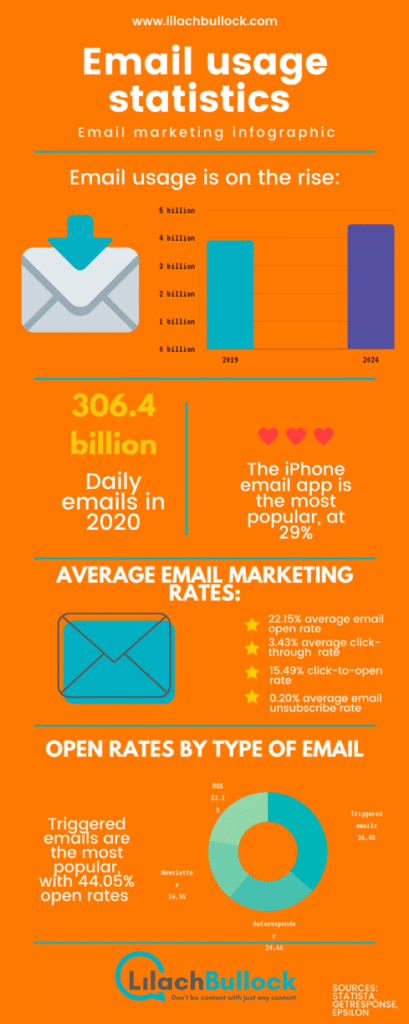
The Gmail app is one of the most popular in the US – and the world. For the past few years, their mobile app has been consistently named as one of top 10 smartphone apps in the United States, reaching over half of the mobile US audience (Statista)
About 63% of US users have only one email account – and 6% have 4 or more email accounts (Statista)
There are approximately 244.5 million email users just in the United States (Statista)
There are currently over 5.6 billion active email accounts all over the world (Statista)
The number of worldwide email accounts continues to grow at a faster pace than the number of worldwide email users. In 2018, the average number of email accounts per user ratio is about 1.75 accounts per user. By 2022, the email accounts per user ratio will reach 1.86 accounts per user. (Radicati)
What should you learn from these stats?
There are 2 important lessons that these email stats teach us:
- That email is one of the best platforms you should be using to market your products and services; not only is email not dying out, it’s actually growing in popularity, with more people using email and creating email accounts, every year
- That you need to make sure that your emails look amazing on mobile phones: people are increasingly opening their emails on their phones so you need to ensure that the content is visible and easy to see no matter what device they use to open the emails you send them
Email open rates and other email opening statistics
As of December 2018, about 43% of all email opens happened via mobile phones (Statista)
21% of sent emails are opened within the first hour upon delivery – the numbers go down considerably from there (GetResponse)
Email open rates are highest in Europe, with a 26.84% average open rate and 4.35% click-through rate, while America has a 19% average open rate and a 2.98% click-through rate (GetResponse)
The average email open rate worldwide is 22.15%, while the average click-through rate is 3.43% (GetResponse)
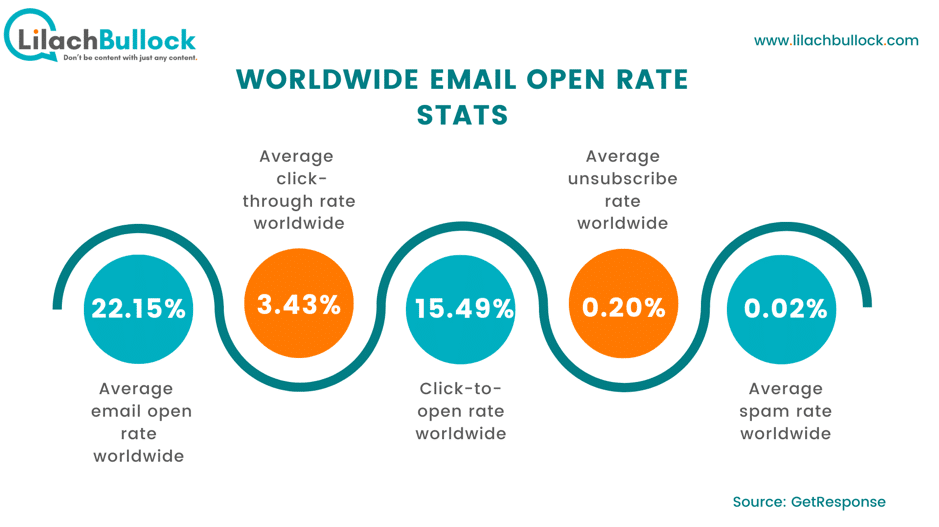
Germany and the Netherlands have the highest average email open rates, 40.47% and 35.34%, respectively (GetResponse)
The fewer newsletters you send, the higher the average open rate: for one newsletter per week, the average open rate is 33.40%, for two newsletters per week, it’s 26.87% and continuously drops the more newsletters are sent (GetResponse)
In terms of types of marketing emails, triggered emails have the highest open rates at 44.05%, followed by autoresponder emails at 29.77%, RSS feeds at 26.78% and newsletters at 20.48% (GetResponse)
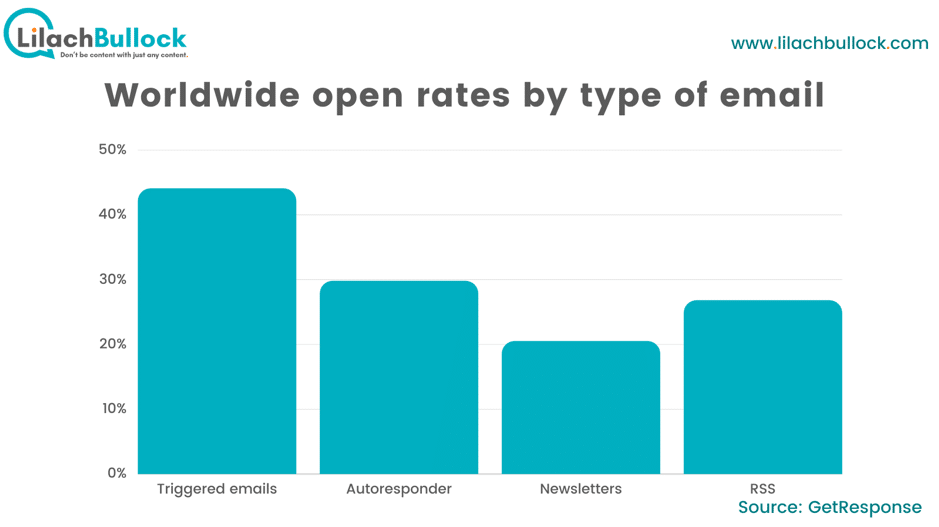
Desktop email clients’ open share is continuously declining, now currently at 18%, and webmail accounts for 39% of opens (Statista)
What should you learn from these email stats?
First, that you should check your email open rates and click-through rates to see how they compare against the average and if you should work on improving them.
And secondly, that you need to send optimized emails that work perfectly on all devices.
And last but not least, that you should set up more triggered emails to increase your email open rates and click-through rates.
Interesting stats and facts about spam emails
About 45% of Internet users report that they avoid opening emails from unknown email addresses (Statista)
As of March 2020, spam messages accounted for 53.95% of all email traffic. During the period of the measurement, Russia generated the largest share of unsolicited spam emails, at 20.74% of all global spam email (Statista)
Global email spam rates are actually going down: in 2012, the global spam rate was at 69%, while by 2018 it fell down to about 55% (Statista)
As of the end of 2018, about 85% of marketing emails landed in a customer’s inbox while 7% were considered automatically spam by spam filters (Statista). Almost 23% of the average email list degrades in just one year (The ZeroBounce Email List Decay Report). Invalid emails are the most common types of undesirable email addresses that affect databases, followed by catch-all emails and abuse emails (people who mark many emails as spam).
The spam placement rate of commercial emails has actually declined in past years: from 14% in 2017 to 9% in 2018 (Statista)
What should you learn from these stats?
The good news is that spam is going down – and about 7% of marketing emails are considered spam by email spam filters.
But if you want to make sure you’re not in that 7%, you need to work on your email subject lines and content to ensure that emails are going to inboxes rather than the spam folder.
Email marketing statistics and trends
Email marketing has one of the highest ROI (return on investment) rates: 4200% or $42 for every $1 spent, up from 3800% in 2018 (CampaignMonitor)
Marketing content represents the majority of all email communications worldwide, but it also has some of the lowest performance metrics (Epsilon Email Communications)
About 35% of marketers report sending their customers around 3-5 emails per week (Hubspot)
Service-related email messages had the highest unique open rates of business emails in 2019, at 38.2% (Epsilon Email Communications) – check out the stats for the rest of the different types of business emails below:
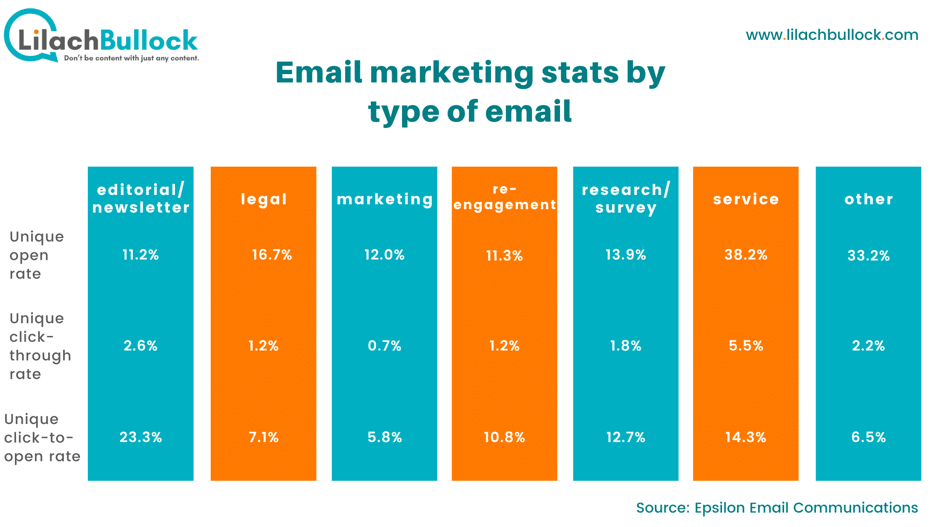
80% of business and marketing professionals say that email marketing increases their customer retention rates (Emarsys)
Automated emails average 70.5% higher open rates and 152% higher click-through rates than regular marketing emails (Epsilon Email Communications)
Interactive emails are starting to grow in popularity – about 23% of marketers have started experimenting with various interactive elements in their emails – and another 32% say that they’re planning to try out interactive elements in emails soon (Hubspot)
Marketers who use segmented campaigns generate up to 760% increase in revenue (Hubspot)
As many as 70% of brands don’t measure their email marketing return on investment well enough (Litmus)
In most cases, marketers focus only on popular metrics such as open rates, click-through rates and bounce rates (Litmus)
Only 46.7% of marketers track their email marketing ROI, and just about 27.7% measure their subscriber’s lifetime value (Litmus)
59% of consumers say that marketing emails influence their purchase decisions (Hubspot)
31% of B2B marketers say that email newsletters are the best tactic they use for nurturing leads (Content Marketing Institute)
As many as 59% of marketers say that email marketing is their best – and biggest – source of return on investment (Emma)
Leveraging A/B testing in your email marketing strategy can generate returns of up to 37% higher (Hubspot)
What should you learn from these stats?
1, send more automated emails – you can do this easily with most email clients!
2, use email marketing more: it has one of the highest returns on investment of all digital marketing practices, a staggering $42 for every dollar spent!
3, experiment with A/B testing as much as possible, both in terms of your subject lines and your email copy – this way, you’ll be able to find out which emails generate the best results and therefore, increase your email markeing ROI considerably.
Email subject lines stats and facts
Using (some types of) emojis in your subject lines can actually increase your email open rates (BusinessWire)
47% of email recipients open emails based on the subject line, while 69% of recipients will report an email as spam based solely on the subject line (Business2Community)
Email without any subject line can actually perform better than those with a subject line – one study reported 8% more opens for emails with no subject line (Business2Community)
According to numerous studies, Tuesdays are the best days to send emails as they generate the highest open rates; but make sure to also check your email analytics to see which days work best for your business!
While Tuesdays are the best days in terms of email open rates, Thursdays and Fridays get the highest click-to-open rates: 14.4% (Campaign Monitor)
Click-through rates are their lowest on Saturdays and Wednesdays, but most days they tend to stick around 2.6% per one study (Campaign Monitor)
Some of the best words to use in your email subject lines to increase your open and click-through rates are: “newsletter” at 31.43%, PDF at 30.31% and EBook at 27.84% (GetResponse)
Over 86% of B2C marketers in North America use emails as the primary channel for delivering content to their audiences (Content Marketing Institute)
Email marketing, although accounting for as many as 19% of sales, only gets about 13% of total marketing spend (Econsultancy)
44% of B2B marketers consider emails to be their best source of leads (Chief Marketer)
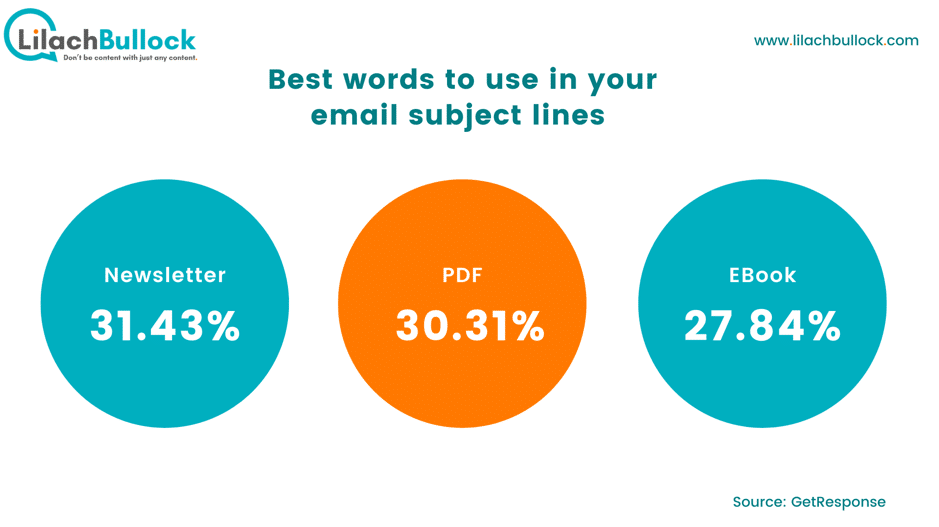
What should you learn from these email stats?
Mostly, that subject lines are incredibly important and make the biggest difference to your open rates.
Experiment with different types of subject lines, use different words and phrases and see how it affects your open rates: chances are, you’ll notice some patterns pretty quickly!
Conclusion
Email marketing is not just here to stay: it’s actually growing every year, as statistics clearly show us.
By leveraging this powerful marketing channel, you’ll be able to reach more of your audience, generate more traffic to your website, increase your sales and conversions and ultimately, grow your business.
Use the stats presented in this list to help inform your email marketing strategy so that you can grow your email marketing success now.

Follow Lilach















